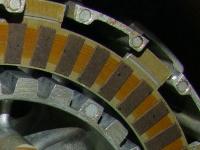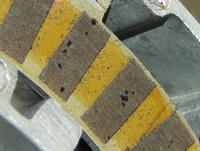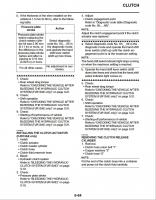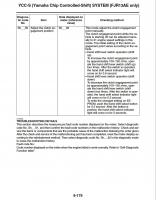odot
CC member # 17,----- DUP member # 7, mensa club m
Ya know what...........I think you need a new battery.

Your bike was warmed up.There should be no bad behaviour trying to move the bike against either brake.Watching your video, I have a thought about the problem. Obviously, in the video, you are holding the bike back with the brake, and the bucking is to some extent due to the computer program recognizing that the bike is not going anywhere and releasing the clutch after having engaged it.
I know that you do not ride this way so I am not going to suggest anything stupid, like "learn to ride." Instead, I wonder if your problem is a sticking brake pedal, or possibly a sticking caliper. Maybe the problem is not a computer controlled clutch problem at all, but a regular old problem with an unlubricated brake pedal pivot. Just a thought...
The rear brake most of us use during slow manoeuvring, holding it hard on simply makes the engine work harder against the stationary rear wheel.
Against the front brake, a little storey. One rider I've toured with many times rides a conventional FJR, and has often bantered with me over my AS.
We were both ready to move off, waiting whilst others of the group got ready. He held his front brake on, and started to engage his clutch with a bit of throttle to make the bike ride against the front suspension. Said to me, "Bet you can't do that."
So I held my front brake on and wound on the throttle a bit so that the clutch started to engage, the bike pushing against the front suspension. "Bet you can't do this!", said I, giving him the bird with my left hand.
Engagement was as smooth as silk.
I delayed replying so that I could do a "cold" test, to make sure my memory was still functionalYour bike was warmed up....
Engagement was as smooth as silk.
If the bike isn't warmed up, you can get this jump against the brake. It's not a defect.
Once its warmed up, you can't induce it and instead you see what you've described. Not so good for the bike though, as you are wearing the friction materials by holding the bike against the brake. This is one of the reasons why I avoid used bikes. It's always a lottery.


If by warmed up, you mean 45 minutes of the highway then yeah. That's how long it takes for my bike to stop doing it. Right after start up, on an incline, you could probably break something it's so bad.Your bike was warmed up.There should be no bad behaviour trying to move the bike against either brake.Watching your video, I have a thought about the problem. Obviously, in the video, you are holding the bike back with the brake, and the bucking is to some extent due to the computer program recognizing that the bike is not going anywhere and releasing the clutch after having engaged it.
I know that you do not ride this way so I am not going to suggest anything stupid, like "learn to ride." Instead, I wonder if your problem is a sticking brake pedal, or possibly a sticking caliper. Maybe the problem is not a computer controlled clutch problem at all, but a regular old problem with an unlubricated brake pedal pivot. Just a thought...
The rear brake most of us use during slow manoeuvring, holding it hard on simply makes the engine work harder against the stationary rear wheel.
Against the front brake, a little storey. One rider I've toured with many times rides a conventional FJR, and has often bantered with me over my AS.
We were both ready to move off, waiting whilst others of the group got ready. He held his front brake on, and started to engage his clutch with a bit of throttle to make the bike ride against the front suspension. Said to me, "Bet you can't do that."
So I held my front brake on and wound on the throttle a bit so that the clutch started to engage, the bike pushing against the front suspension. "Bet you can't do this!", said I, giving him the bird with my left hand.
Engagement was as smooth as silk.
If the bike isn't warmed up, you can get this jump against the brake. Its not a defect.
Once its warmed up, you can't induce it and instead you see what you've described. Not so good for the bike though, as you are wearing the friction materials by holding the bike against the brake. This is one of the reasons why I avoid used bikes. Its always a lottery.










I did not say that you WOULD get that behavior. I said you CAN get that behavior, and perhaps I should have gone further and modified the Can to be a Could, but in American vernacular, there is no use of the subjunctive anymore. Subjunctive is implied.Your bike was warmed up....
Engagement was as smooth as silk.
If the bike isn't warmed up, you can get this jump against the brake. It's not a defect.
Once its warmed up, you can't induce it and instead you see what you've described. Not so good for the bike though, as you are wearing the friction materials by holding the bike against the brake. This is one of the reasons why I avoid used bikes. It's always a lottery.
Tried it this morning. Started it cold and immediately rev'd it against the back brake then the front. Even with the high cold revs it behaved perfectly, no jerkiness at all. Still smooth as silk.
I'd say you should never...I did not say that you WOULD get that behavior. I said you CAN get that behavior, and perhaps I should have gone further and modified the Can to be a Could, but in American vernacular, there is no use of the subjunctive anymore. Subjunctive is implied.
In any event, yours is adjusted, and perhaps even "worn in" to the point where you don't see this.
That's great!
I'm rather surprised to see, but nowhere in this topic the adjustment of clutch engagement point is mentioned: I looked at the video and the bike's behaviour is the same I experienced when, as I tried to fine-adjust it, the engagement point was set too low.
I do believe that this procedure (well explained in the service manual) would help a lot or even solve your problem.
Agreed. I've done the "against the brake" test also from 10 seconds after having started it (stone cold) to full temp bars (full hot) and never had an issue. Also cold from a steep uphill parking slot against the curb, two up with full gear. Nary a problem with 60,000 milesI'd say you should never...I did not say that you WOULD get that behavior. I said you CAN get that behavior, and perhaps I should have gone further and modified the Can to be a Could, but in American vernacular, there is no use of the subjunctive anymore. Subjunctive is implied.
In any event, yours is adjusted, and perhaps even "worn in" to the point where you don't see this.
That's great!get that behaviour. I don't think there is any significant "wearing in" for anything to do with clutch operation, and the only adjustment I can see (after scouring the workshop manual) is for the engine speed at which the clutch engages/disengages.
the workshop manual) is for the engine speed at which the clutch engages/disengages.
Yes, mine suffered from minor juddering, which is why I soaked its clutch, and that seems to have cured it (at least for a few thousand miles). But that was nothing like the violent behaviour shown in
Ok, I give in, there is one adjustment that at first sight seems to be mechanical, and would be done after a master cylinder rebuild (or presumably at the factory), and depends on a shim thickness. It is documented in these two manual pages:Lazybear, can you give us the page/chapter number in the service manual that shows how to adjust the engagement point? Mcatrophy is rarely wrong but there's always a first time



Great news!Well, I guess they fixed it. ...
The clutch engaging and disengaging at higher revs makes it a lot harder to control.
What are "higer revs"? I just checked mine and the clutch starts engaging about 1600-1800 RPM's which I think is about right. Fully engaged shortly thereafter.
The system is great, but will never be as smooth as a manually operated clutch could be. Probably a number of us around here that would argue this point however we could all do that forever.
I can't say for sure yet how much I like it because I have to re-learn how to ride it smoothly. Probably have to learn how to drag that rear brake. Yes, that is a big part of slow speed manuevering. A number of threads around here on AE riding techniques. Remember, it can shift like a ton of bricks and bang around somewhat if you baby it at low speeds and low revs. Mine does, hot or cold, when I'm puttering out of the neignborhood. Run it up to 1/3 throttle and 5,000 RPM and you can barely feel it shift.
However, I was thinking about what I've done to this bike and when. The problem may very well have started when my Dad and I synced the throttle plates. Thanks for all your help everyone. Glad to help, AE'er got to stick together! If you can't find the technique threads that answer your operating questions, PM one of us for more details.